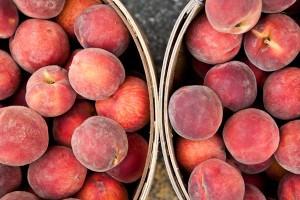 Detroit’s Eastern Market has been a hub for connecting growers with buyers in Southeast Michigan for over 100 years. Now it’s evolving into a food hub, helping to seed a regional food system based on a network of small, local growers, food processors, and creative retail and wholesale interactions throughout the natural food chain.
Detroit’s Eastern Market has been a hub for connecting growers with buyers in Southeast Michigan for over 100 years. Now it’s evolving into a food hub, helping to seed a regional food system based on a network of small, local growers, food processors, and creative retail and wholesale interactions throughout the natural food chain.
Eastern Market’s influence extends well beyond its urban roots to rural farmland south to the Ohio border, across the international border to Ontario, north into the Thumb, and west beyond Ann Arbor.
With the nation’s farmers aging and family farms struggling to compete with corporate farms, one of the main functions of a food hub is to develop young farmers, beginning on small plots, and helping them expand in their skills and production capability, explains Dan Carmody, president of the nonprofit Eastern Market Corporation. Michigan State University’s Extension will begin a farmer training program in the market area next summer to complement the existing training offered by Greening of Detroit.
The food hub helps small farmers grow the size and yield of their farms and create other viable sales outlets that aren’t community supportive agriculture (CSA), a farmer’s market, or direct sales to restaurants because “farmers have to balance their time between selling food and growing it,” Carmody says. “It’s the next step in the devolution of a food system into a stronger regional system, encouraging smaller growers.”

By small, he means small. “One of our city growers on six lots (is) looking to buy nine acres in the suburbs — not to replace but augment what he’s got,” Carmody says. He’s working with foundations to create a micro-loan program to help farmers and food processors establish their businesses.
Carmody and his staff have increased the profile of local and regional growers supplying the market, says Debbie Tropp, branch chief of the Agricultural Marketing Service of the U.S. Department of Agriculture, which is conducting a two-year study of Eastern Market. “They’re doing their level best to try to revitalize the regional food system in a way that may not have happened prior.”
Eastern Market is considered a “hybrid market,” where wholesale and retail activities occur, one of about 50 in the nation, according to James Barham, agricultural economist and head of a USDA interagency task force on regional food hubs. “Hardly any of these would be classified regional food hubs. Mainly, it’s a property manager who’s leasing space. What Dan is doing is pretty remarkable. He could have set up as a property manager and leased space. Eastern Market would have continued to exist.”
Food hubs are a fairly new designation for comprehensive agricultural centers that provide a catalytic impact on the regional food system, says Barham. “Because of the strong relationship regional food hubs have with producers, and because of the demand for locally grown product, producers are scaling up their operations, they’re hiring more staff, they’re planting more crops, they’re switching practices from more conventional to more sustainably produced because there’s higher customer demand for that type of product.”
Eastern Market has established a virtual food hub to connect the region’s growers and buyers in an unprecedented way using Local Orb.it. “The buyer can go online and pick Eastern Market as their hub, see a variety of our growers, our specialty product vendors, and be able to order from these different types of growers on one purchase order,” says Christine Quane, wholesale market coordinator for Eastern Market. “That allows growers to tell their story, inventory their items and put their wholesale pricing [on display]. They pick their products, make their orders, and the two meet on a set day — saving time for both. By knowing the story behind the grower, they know where their food is coming from. They’ll know who the growers are and how they grow.”
The produce is here. The economic opportunity is in processing, says Carmody. For example, last year the market connected a tortilla maker, which had been using national corn exclusively, with Michigan corn growers. “That’s the painstaking work of trying to relocalize the food system and add jobs by trying to build the content up.”
Michigan is second only to California in terms of crop diversity, but the state is in the 20th percentile for food processing, he says. “We’re not taking Michigan crops and making value-added products out of them. We think that is one of our most important functions — how to encourage that food processing piece to expand.”
At Eastern Market, entrepreneurs can develop and test-market their products, then go regional. McClure’s Pickles is an example. The Troy firm got its start at the market and has since expanded regionally and into other states. Eastern Market will add a professional catering kitchen for businesses that need something more than a household kitchen to make edibles.
Unlike Ann Arbor and surrounding communities, Eastern Market doesn’t have preserved green space for agricultural development. However, it is surrounded by about 40 miles of vacant land, much of it already becoming cultivated by community growers.
So, could urban agriculture be a significant source of fresh food for the metropolitan area? “The term metropolitan agriculture makes more sense than urban agriculture, if you’re looking at food production,” Carmody says. “Could Detroit possibly be this hub? Technically the answer is yes, if you devoted a substantial amount of the vacant land to agriculture. We need to think about agriculture, whether it’s urban, suburban, or rural within the metropolitan area.
“A farmer in Detroit shouldn’t think about growing crops just for Detroit residents. They should be growing crops to make money; if that includes selling to restaurants in Ferndale or Troy, bring it on … just like a farmer in St. Clair County or Monroe County shouldn’t be thinking about just selling to residents within their region.”
Rob Ruhlig’s family farm in Monroe is an example of regional farms that sell through Eastern Market’s wholesale operation and retail flowers in the spring. A member of the Eastern Market board of directors, Ruhlig says the market is focused on increasing its role in producing products that can be sold regionally.
There has been a subtle but noticeable change in preference for local produce at the market, notes Ruhlig, who routinely meets with buyers from markets like Nino Salvaggio, Westborn Market, and Hillers during the growing season. “Some of the high-end markets want the very best, so they want to hand-select and want to know that it has been picked today. The best time to get it is when it’s only three, four, five hours old. It goes right to their stores,” he says.
“People are starting to pay attention to where their food is coming from,” says Ruhlig, whose farm has gradually expanded to over 1,200 acres in recent years. His farm has become better at competing with Californian farms. “It’s fresher and they (customers) know where it’s coming from.”
Carmody believes that Eastern Market is the most comprehensive food hub in the nation, given its role in developing a regional food network. He points to the components of a regional food system, which Eastern Market has, to a greater or lesser extent — production, processing, wholesale, retail, nutrition education, grower training, and waste conversion.”I think we have in one place parts of all those things going on in the same space. I don’t know another place that has all of those things.”
Eastern Market is “a real leader in the diversity of outreach activities that they do,” says Tropp. Adds Burnham, “What we see with Eastern Market, they’re working more closely with producers now. There are tremendous community engagement services, and environmentally, they’re looking at cost-efficient and energy efficient strategies. When it comes down to it, there aren’t many models that are that all-encompassing.”
In March, the USDA will publish a regional food hub resource guide which will include a comprehensive definition of a food hub, with data and case studies as well as a compilation of federal, nonprofit, and foundation resources that support food hub activities. Go to www.ams.usda.gov/foodhubs.
Source: Model D / Metromode/ Photographs by Marvin Shaouni Photography



